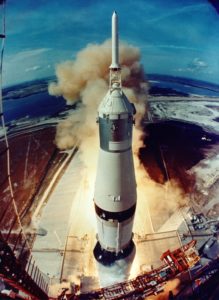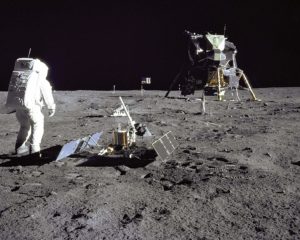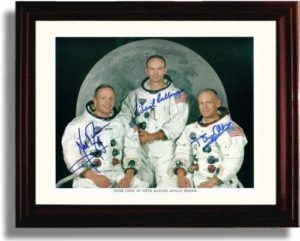“We choose to go to the moon in this decade and do the other things, not because they are easy, but because they are hard. Because that goal will serve to organize and measure the best of our energies and skills, because that challenge is one that we are willing to accept, one we are unwilling to postpone, and one which we intend to win, and the others, too.” —President John F. Kennedy, 12 September, 1962
Chasing the Moon
Ever since appearing on Earth, humans have looked to the night sky, marveling at celestial bodies. One in particular was the intriguing source of speculation, a fount of legends: the Moon. From poets and scientists to artists, many have dreamed and been inspired by Earth’s one orbiting satellite, and wished for the day when they could go there. That heroic journey was long in coming.
The technology and will power to accomplish such a daunting task would have to wait until the 20th Century, during a time often referred to as the Space Race. The United States and the then named Soviet Union were rivals toward the conquest of space. Many trials and errors ensued, even disasters, such as the three Astronauts on Apollo 1 (Ed White, Roger Chaffee, Gus Grissom) who perished in a flash fire inside the capsule during a mock launch exercise. This was a dangerous quest.
Computers were in their infancy; in the early 60’s calculations were made by slide rule. Today’s cell phones have more storage and computing capacity than those rudimentary giant framed computers. The scientists persisted, pushing current technologies to their limits, and the ancient dream was close to being realized: landing people on the Moon!
What an exciting time to be alive! One could palpate the thrill in the air—and the anxiety. The lunar expedition was the constant topic of both children and adults. Imagine the angst and concerns of the families of the astronauts—“Honey, I’m going to the Moon. I’ll be back in a little over a week. Make sure the kids behave themselves.” They put their lives in the hands of the men and women who originated new methods for this perilous voyage—trusting all to be doing their very best.
Finally, on the morning of 16 July 1969, the massive Saturn V rocket, with Commander Neil Armstrong, Command Module Pilot Michael Collins and Lunar Module Pilot Buzz Aldrin aboard the Apollo 11 Space Capsule, shook the Earth as its giant motors ignited, lifting the crew into space on a column of fire. Those who have not seen an Apollo capsule, well, imagine yourself and two other people sitting in the back of a Volkswagen, surrounded by instruments, switches and knobs! Inside such cramped quarters, they peered out of the small portals to see the vastness of space stretching to infinity.


After three days of travel, Apollo 11 was in orbit around the Moon, and on 20 July 1969—after missing the landing spot and with barely enough fuel—the Eagle (Lunar Excursion Module) landed on the Moon; Collins remaining in orbit. Millions watched that grainy black and white image on their TV sets and saw Armstrong step unto the lunar surface and utter the words “One small step for man, one giant leap for mankind.” The Astronauts explored and experimented for two hours and thirty-five minutes, and then left behind a memorial plaque that reads “Here men from the planet Earth first set foot upon the Moon July 1969 AD. We came in peace for all mankind.”

Their return to Earth was met with mighty cheers, then parades, and all manner of celebrations. And, on this 50th anniversary of that momentous expedition, celebration is what is indicated now. Celebrate this monumental achievement by looking at the pictures, documentaries and video, imagining what this magical time was like. Celebrate the triumph of science, reason, engineering and bravery embodied in the Apollo program. And, for those of us who were alive during that epoch-changing event, we remember with awe and pride the thrill of that moment in 1969 when humans finally looked to the Moon and said to themselves “Yes, my kind was there.”
—Magister George Sprague


